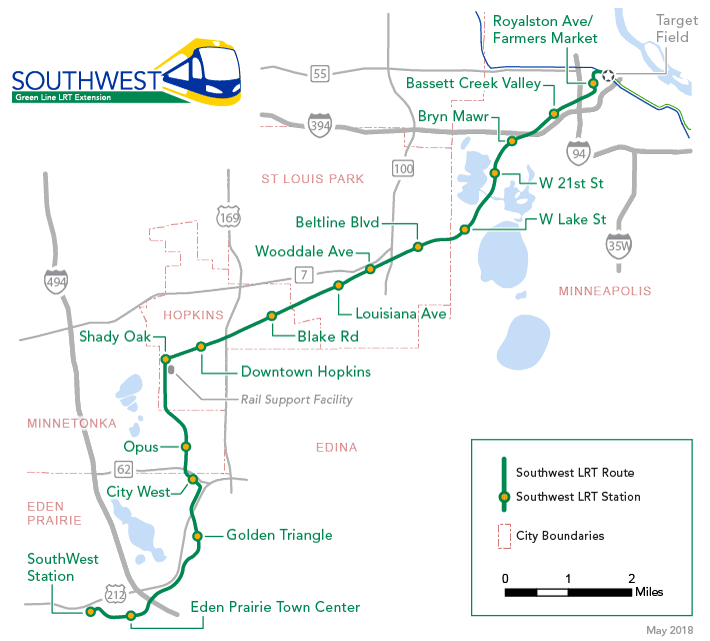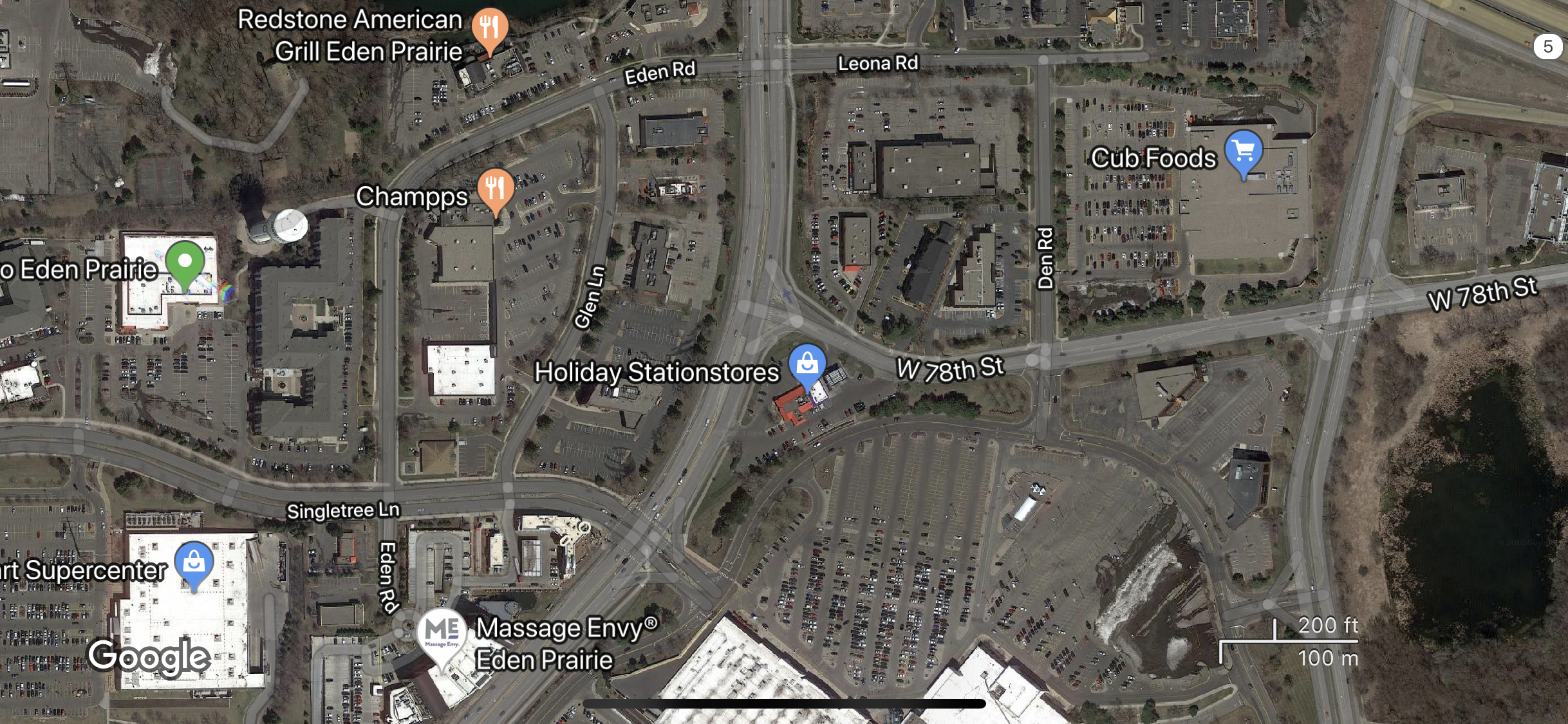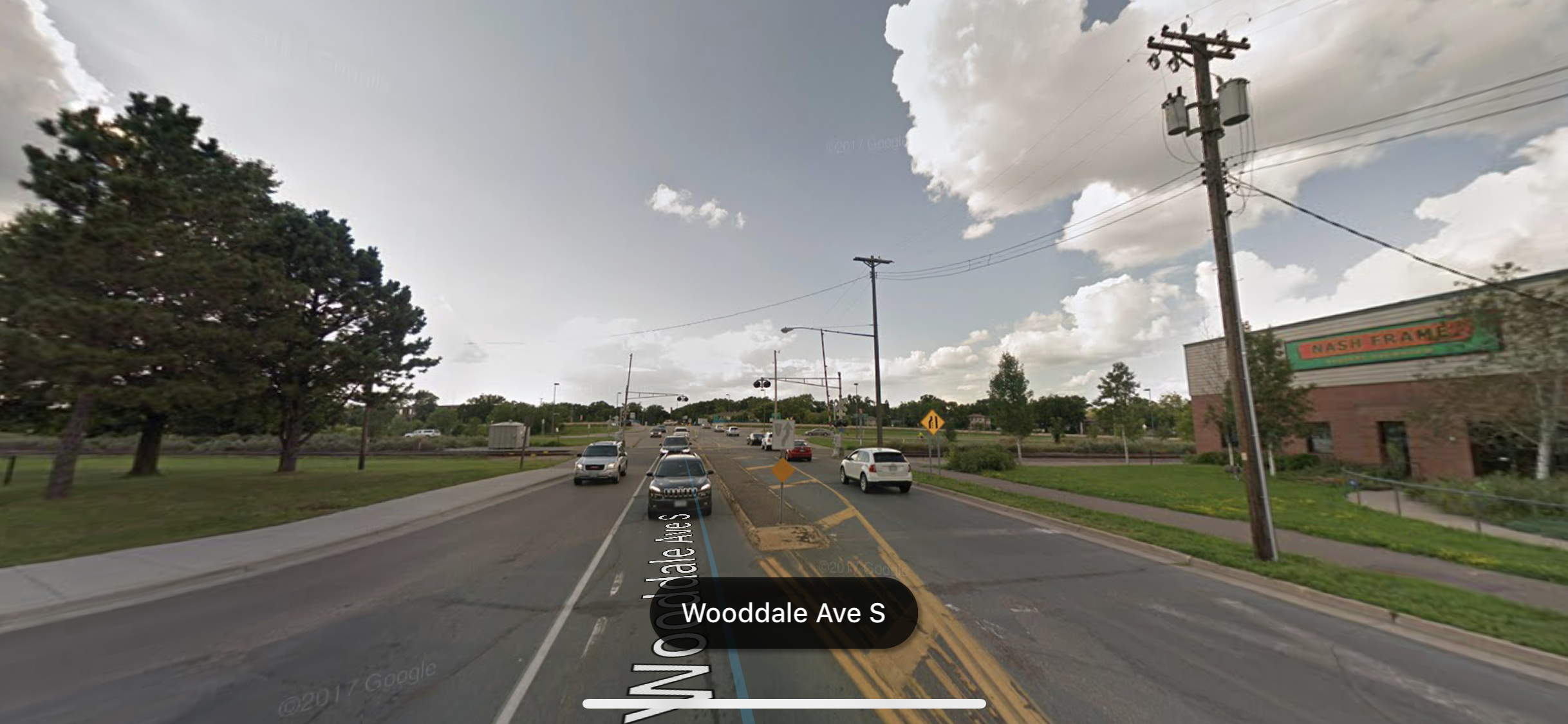Southwest Light Rail Breaks Ground Today After Breaking Twin Cities Transit Planning For Years
Hello all,
In an interesting twist, today is the ground breaking for the Green Line extension, also known as the Southwest Light Rail project. This big, beautiful guy will travel from Target Field Station in downtown Minneapolis to the outskirts of a mall parking lot in Eden Prairie, Minnesota. As you are certainly well-aware at this point, this is the likely conclusion of a process that was painstakingly arranged back in the 1980s, before I was born.
This $2 billion dollar train will get from downtown Minneapolis to the suburbs through the Kenilworth Corridor, an old railroad corridor that’s had trains in it for like a hundred years, because Hennepin County bought some land there decades ago. At one point, it was deemed cheaper ($1.2 billion) to build through this area at grade rather than build through Uptown Minneapolis ($1.5 billion), and faster for suburban commuters to zip directly into the city than jog over to Nicollet before heading north. Later it came to light that some consultants did some math wrong, and we would instead decide to build a tunnel under a bike trail in Kenilworth, in a park, in our normal world. It’s also under appreciated how much complex, expensive engineering there is out in the suburbs on this line.
Light rail, a transportation mode that runs big trains at regular, pretty good frequencies throughout the day, will be built through marshes and across suburban freeways and among big box stores and light industrial parking lots. Outside of those couple hours of rush hour where people will take trains to and from downtown Minneapolis, the Green Line extension will serve the important market of people who are going to take 45 minutes to drive to a train station in Eden Prairie, park in a large ramp, walk to the platform, wait for a train, take it to Hopkins, walk across a seven lane road, and walk several blocks to their job, rather than just drive from their home to their work in 10 minutes.
Without getting too deep into the specifics of the late 2000s “debate” over where this train should have gone, we can say in short that it’s a victory for a certain mindset in transit planning—one that values certain things (suburban commuters, a handful of large suburban developers, etc) over other things (moving lots of people quickly in a cost-efficient and reasonably environmentally-friendly way, etc). It’s also a huge win for inertia, the most powerful force in Minnesota, reaffirming that “we had a bunch of meetings” can justify just about anything.
Transit (moving people around, etc)
As a train, I would say that it is maybe not a great example of transit, in that it will be slower than the buses that are there now, and those buses are on routes that we could easily add more buses to if there were capacity issues, which, are there? I don't think so. That being said, that doesn't mean that the project the train is part of does not have benefits! It's useful to separate the Green Line extension that's being built from the Southwest Light Rail project, which is much more complicated.
Train Politic’s
Probably the biggest benefit of the project, and the one you never really heard articulated all that well due to it sounding shady when you say it out loud, is that it drives a big, train-shaped stake right into the heart of the wealthy (and therefore powerful) southwest metro, tying them, politically, to transit as an idea. This general area includes not just Eden Prairie, but also places like Minnetonka and Chanhassen and to a lesser extent, Edina and all the little wealthy enclaves along the south and east side of Lake Minnetonka. A few hundred thousand people live there, and it is an important and, not to belabor the point, wealthy area. Lots of important and wealthy people live there, and five years' time they'll find themselves living in a different sort of place, a more big city-ish type place, because even though Minneapolis is still ten miles away and not where they live, they can now drive to a nice train station and park in a well-lit parking ramp for free and take a train there pretty easily, like they could in a suburb of Chicago or New York or something.
That maybe sounds silly, but if you think about it, it will be a big psychological change for those people in those areas, which I mentioned were important and wealthy, and I suppose that it is not bad for [insert United Health Group executive here] to ride the train to Twins games a few times a year and feel invested in the system.
It also cements downtown Minneapolis as the center of the region, something that seems far less necessary to do in 2018 than it probably did in 1998, but it’s something. This one is kind of intangible, but it’s there. I wouldn’t be shocked if a couple medium-big southwest metro employers decided to move downtown in the next few years, something that could have happened regardless of the train, but they’ll put it in their press release so I’m just getting out ahead of that.
Aside from a handful of development projects (and we’ll get to that later) that maybe are a bit better than they would have been otherwise, those are my pros. What else has the project done?
The Conversation
For over three (3) years now, I've spent a bit of time being somewhat part of ~the establishment~ by serving on the Planning Commission of an anonymous local burg, and among many Actually Good things that happen with that, I've gotten a little bit of a personal taste of a particular kind of bad, smarmy thing: implicitly defending some bad thing or process because in doing so, you get to show off how much you know about it. You just don't understand that we have to make very specific legal findings to deny this application—so we have to approve this single story drive-through bank and its surface parking lot. It makes you feel fancy without doing anything about the problem that makes this case.
And that specific tone is allllll over the Green Line extension. Which is sort of fair; to an extent, every individual Star Tribune comment asking "why don't thye just put it thru Uptown?? ?" is dumb and doesn't know what it's talking about, even though the underlying point is correct. Yes, it’s an enormously complicated project with lots of things going on and moving parts and processes. The rub is that over the literal years (bad alignment picked ca. 2009, Kenilworth tunnel emerged ca. 2013, Eden Prairie soil nightmare appeared ca. 2015, mile long wall and bidding issues surfaced ca. 2017) in which this thing went further and further down hill, the comment, regardless of misspellings and lack of knowledge of the inner workings of the Federal Transit Administration, got less dumb.
This is a long period of time! World War II was like six years long, and we invented nuclear weapons during that, among other things. If we had scrapped Southwest light rail in 2013 when things really went off the rails, we obviously could have figured something out.
Would it have been a Hennepin Avenue subway? Who knows! I doubt it. But these obstacles aren't really financial, they're political. If Southwest light rail cost $5 billion, its supporters would still support it, if it cost $500 million, its opponents would still oppose it. That $4.5 billion gap in the middle probably has a lot to do with why public works projects in the United States cost several times more than those in other countries.
We could, in a matter of months, take out parking and driving lanes across Minneapolis and St. Paul and the first ring suburbs and put in bus-only lanes and give the buses signal preemption, giving us near-real Bus Rapid Transit (the actual thing) all over town. We'd be able to completely fund it all by ourselves. But we haven't done that, because we've blown a decade of political capital trying to line up local money to get state money to end up going with local money to secure federal money to build train bridges through marshes for commuters in second-ring suburbs. If funding was the obstacle to building transit, the Midtown Greenway would have sure as hell have gotten a train in it before even University Avenue.
And there's a related type of comment that I think is much more well-intentioned then the above, but still damaging, and that's the immediate wagon-circling from certain quarters when faced with any type of transit planning criticism generally. There was a lot of this when the Green Line opened up a couple years ago; I specifically remember a joke that the Green Line was bad because it wasn't a bullet train that got you immediately from Point A to Point B, or something like that.
The Green Line? Obviously good.
But also, the damn thing should go faster. Why the hell is a train with 250 people waiting at a red light for a single Toyota Camry to cross University Avenue? That "it wasn't designed to be taken from end to end," or whatever, really is irrelevant; if the train is slower than it needs to be from end to end, then it's also slower than it needs to be from each station to the next station. It's hard to say that for some reason, probably because you don't want to be somehow attacking the Good Thing, the new train we built in the right place after a lot of work. Without getting into the incredibly stupid Metropolitan Council press releases about #spurring #development, there was other Green Line boosterism that felt mindless, like the constant news about blowing up ridership estimates, and that's not exactly a bad thing, but it also makes you wonder what kind of grade separation and other improvements we could have gotten out of the project if the ridership had been forecast more accurately.
So that was 2014, and that's kind of where our conversation was at when the Green Line extension had spent a year turning into a whole thing, and the conversation has continued to go downhill since then! And it's not because of the snark-ers who are mad that they did not get their Uptown train. At this point, other than a handful of litigious folks in Kenwood, people have pretty much made peace with the project, and just want it to get built so we can stop talking about it.
But what do we talk about, when we talk about transit in the Twin Cities? We talk about "redevelopment opportunities" and congestion relief for freeway commuters and trying to link low density office parks in third ring suburbs with trains that run every 15 minutes, because that makes any sense? We share terrible Star Tribune staff editorials on Facebook that bizarrely argue "well, the millennials need trains now, do one unit of train please." There are, inexplicably, well-paid Twin Cities thought leaders and economic development officials and politicians who earnestly (?) think that running a two billion dollar train past the outskirts of the Eden Prairie Center Mall parking lot will keep recent college grads from moving to Seattle. This isn’t necessarily all new—other than the more recent thing about retaining millennials, professional transit planning in America has, for a while, largely been about dumb things like making exurban commutes easier—but now even the advocates are on board with building transit to pretend to juice economic development in a metro that has had little trouble building lots of stuff.
Frankly, not much of that stuff has had much to do with train stations. We had to build on basically every vacant lot and parking lot in Uptown before people started building more than a handful of things along the Blue Line. Developers have been proposing, financing, building, and leasing apartments and offices along the Green Line extension route since I was in junior high school in St. Louis Park. It seems like those projects have worked out even though the train took 15 years longer than we figured it would.
Misplaced Priorities
The buses in Minneapolis are crowded (because people ride them) and slow and, often, kind of sad. But that's not what we're gonna make transit investments for—somehow, transit is for the guy who wants redevelop a strip mall a half mile from a light rail station in Minnetonka, and off a six lane road with no sidewalks he'll build a three story Days Inn with a surface parking lot and a water retention pond and Finance & Commerce will quote him in the story, "uh, yeah, the, uh, train is a big part of why we want to put a hotel here." Development has been...spurred? Great. And that's what we say! That's what the press releases from government agencies say and what the elected officials say and what ends up in the paper.
We've twisted our entire regional conversation around transit planning to fit the Green Line extension, and for...what, I dunno. Maybe so like, three or four people didn't have to admit that they messed up.
It would be nice to be able to end on a happier note, here, but I'm not sure where to go with it. The planned Blue Line extension up to Brooklyn Park follows the same type of park routing through the city out to the suburbs and is somehow even less useful; the Gold Line out in the east metro is hilarious. They want to build a tunnel under Fort Snelling for a streetcar that will run in mixed traffic in St. Paul? There’s billions poofed into the ether here. What are we doing? Haven't heard a whole lot about Minneapolis streetcars lately—which might be good, since those vanity streetcar projects are the purist distillation of the public sector transit investment for private sector development profit mindset. We celebrate the small victories, like, you know, useful signs at bus stops. The alphabetical arterial bus rapid transit routes are very good, but the A Line on Snelling Avenue in St. Paul should be the standard, not something we furiously celebrate for four months because gosh darn it someone sneakily managed to use transit planning to make transit work better.
Where do we go from here? It's not clear. We talk a bit about the big transit referendums that earthquake-prone death traps like Los Angeles and Seattle have passed, and drool a little bit over the dollar amounts there. Unfortunately (?) Minnesota law does not allow cities or counties to impose their own sales taxes to raise money for things like transit without state permission. It would require a bunch of lobbying at the state, or I guess better legislators. So we'd probably have to go doorknock all summer and get our moderate Republican fathers-in-law in Maple Grove on board.
But, you know, for what?
If the region came into $10 billion dollars tomorrow, Hennepin County would rig another alternatives analysis and we'd use it to fund the local half of a subway under I-494, opening in 2038. To balance it out on the east side of town, we'd...God, I don't even know, buy every household in the east metro a used Kia Rio and call it personal rapid transit? The car washes and Jiffy Lubes would be great economic development.








